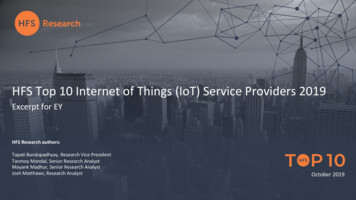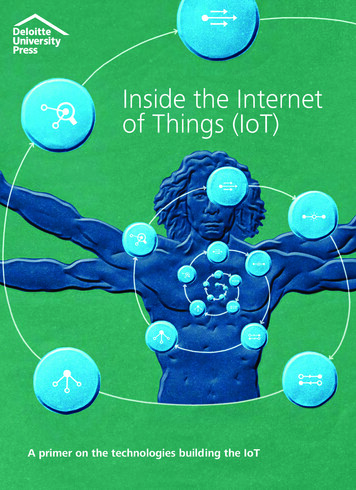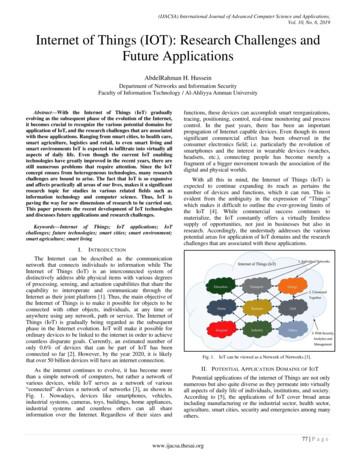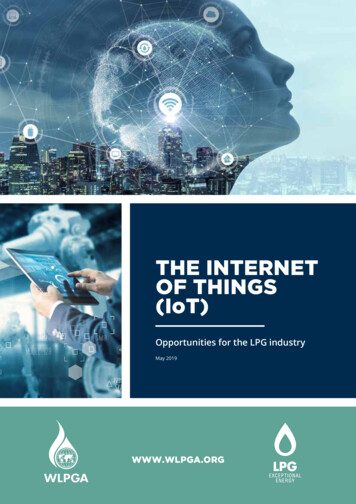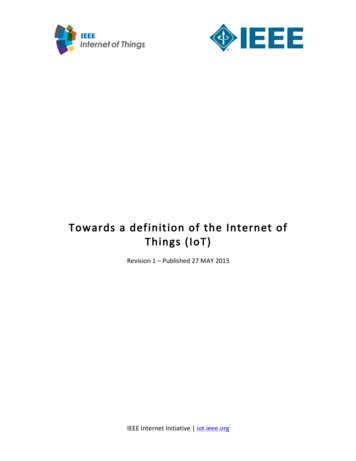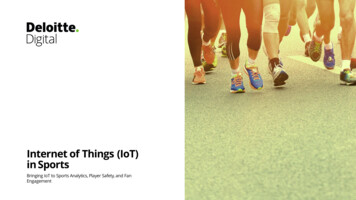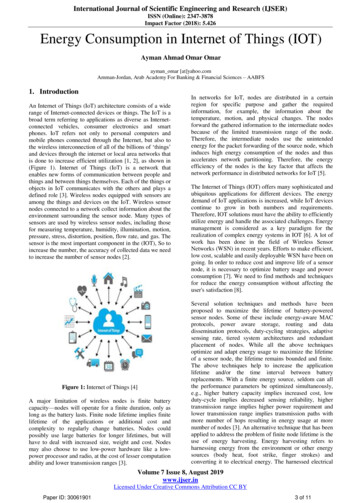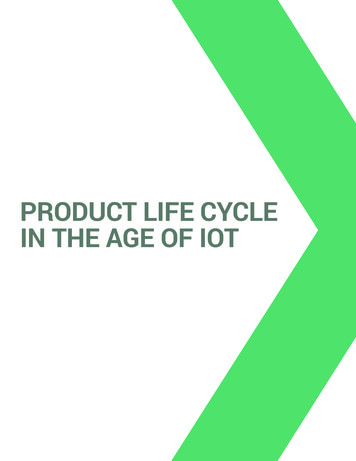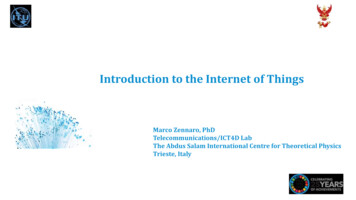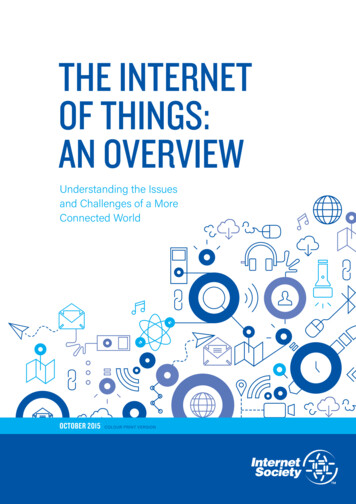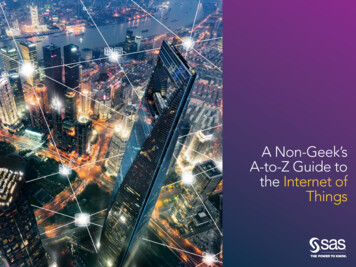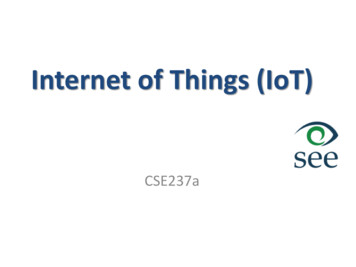
Transcription
Internet of Things (IoT)CSE237a
Class Overview What’ve covered until now in SW:– Everything!!!!! Where we are going today:– IoT Due today:– Articles on IoT Upcoming:– HW3 assigned– Final project due Thursday– Exam the last day of class; no book/notes Bring one 8 ½ x 11” sheet of paper with handwritten notes– Course evaluations are out!!!! Please provide your feedback re. course – we take your feedbackvery seriously and look forward to hearing from you!
What is IoT? A phenomenon which connects a variety of things– Everything that has the ability to communicate3
Connection of Multiple VisionsSource: Atzori et al. 20104
IoT Definitions The Internet of Things, also called The Internet of Objects,refers to a wireless network between objects, usually thenetwork will be wireless and self-configuring, such ashousehold appliances. (Wikipedia) The term "Internet of Things" has come to describe anumber of technologies and research disciplines thatenable the Internet to reach out into the real world ofphysical objects. (IoT 2008) “Things having identities and virtual personalities operatingin smart spaces using intelligent interfaces to connect andcommunicate within social, environmental, and usercontexts”. (IoT in 2020)5
IoT Evolution Starts with only network and evolves intoeverything that can be connected with anetworkSource: Perera et al. 20146
Any-X Point of ViewSource: Perera et al. 2014 The Internet of Things allows people and thingsto be connected Anytime, Anyplace, withAnything and Anyone, ideally using Anypath/network and Any service.7
Characteristics of IoT1. Intelligence– Knowledge extraction from the generated data2. Architecture– A hybrid architecture supporting many others3. Complex system– A diverse set of dynamically changing objects4. Size considerations– Scalability5. Time considerations– Billions of parallel and simultaneous events6. Space considerations– Localization7. Everything-as-a-service– Consuming resources as a service8
IoT Layered ArchitectureSW: Middleware and ApplicationsHW: Sensing And CommunicationSource: ZTE9
Networking and Communication RFID to smallest enabling technologies, such as chips, etc. Mobile platforms, such as sensors, phones, etc.Source: Qian Zhang. Lecture notes. 201310
Wireless Technologies Telecommunication systems– Initial/primary service: mobile voice telephony– Large coverage per access point (100s of meters – 10s ofkilometers)– Low/moderate data rate (10s of kbit/s – 10s of Mbits/s)– Examples: GSM, UMTS, LTE WLAN––––Initial service: Wireless Ethernet extensionModerate coverage per access point (10s – 100s meters)Moderate/high data rate (Mbits/s – 100s)Examples: IEEE 802.11(a-g), WimaxSource: Geert Heijenk. Mobile and Wireless Networking. Lecture Notes. 201411
Wireless Technologies Short range:– Direct connection between devices – sensor networks– Typical low power usage– Examples: Bluetooth, Zigbee, Z-wave (house products) Other examples:– Satellite systems Global coverage Applications: audio/TV broadcast, positioning, personal communications– Broadcast systems Satellite/terrestrial Support for high speed mobiles– Fixed wireless access Several technologies including DECT, WLAN, IEEE802.16, etc.Source: Geert Heijenk. Mobile and Wireless Networking. Lecture Notes. 201412
Sensor Networks (SNs) Consist of a certain number (which can be veryhigh) of sensing nodes (generally wireless)communicating in a wireless multi-hop fashionSource: Perera et al. 201413
Sensor Networks (SNs) SNs generally exist without IoT but IoT cannot existwithout SNs SNs have been designed, developed, and used forspecific application purposes– Environmental monitoring, agriculture, medical care,event detection etc. For IoT purposes, SNs need to have a middlewareaddressing these issues:– Abstraction support, data fusion, resource constraints,dynamic topology, application knowledge, programmingparadigm, adaptability, scalability, security, and QoSsupport14
Example: Indoor Localization An indoor positioning system (IPS) is asolution to locate objects or people inside abuilding using radio waves, magnetic fields,acoustic signals, or other sensory informationcollected by mobile devices. For indoor localization:– Any wireless technology can be used for locating– GPS, WiFi, Bluetooth, RFID, Ultrawide band,Infrared, Visible light communication, Ultrasound15
Middleware Middleware is a software layer that standsbetween the networked operating system andthe application and provides well knownreusable solutions to frequently encounteredproblems like heterogeneity, interoperability,security, dependability [Issarny, 2008] IoT requires stable and scalable middlewaresolutions to process the data coming from thenetworking layers16
Service Oriented Architecture (SOA) Middleware solutions forIoT usually follow SOAapproaches Allows SW/HW reuse– Doesn’t impose specifictechnology A layered system modeladdressing previous issuesSource: Atzori et al. 2010– Abstraction, commonservices, composition17
Other Middleware Examples Fosstrak Project– Data – Fault and configuration management, lookup and directoryservice, tag ID management, privacy Welbourne et al.– Tag an object/create-edit location info/combine eventscollected by antennas e-Sense Project– Middleware only collects data in a distributed fashion andtransmits to actuators UbiSec&Sens Project– Focuses on security secure data collection, data store inmemory, etc.18
Open Problems and Challenges Lack of standardization Scalability– Addressing issues– Understanding the big data Support for mobilityAddress acquisitionNew network traffic patterns to handleSecurity/Privacy issues19
Standardization Several standardization efforts but not integrated in a comprehensiveframework Open Interconnect Consortium: Atmell, Dell, Intel, Samsung and Wind River Industrial Internet Consortium: Intel, Cisco, GE, IBM AllSeen Alliance: Led by Qualcomm, many others20
Scalability Number of devices increasing exponentially– How can they uniquely be tagged/named?– How can the data generated by these devices be managed?21
Addressing Issues Incredibly high number of nodes, each of which will producecontent that should be retrievable by any authorized user– This requires effective addressing policies– IPv4 protocol may already reached its limit. Alternatives?– IPv6 addressing has been proposed for low-power wirelesscommunication nodes within the 6LoWPAN context IPv6 addresses are expressed by means of 128 bits 1038addresses, enough to identify objects that need to be addressed RFID tags use 64–96 bit identifiers, as standardized by EPCglobal,solutions to enable the addressing of RFID tags into IPv6 networksEncapsulation of RFIDmessage into an IPv6packet.Source: Atzori et al. (2010)22
New Traffic to Handle The characteristics of the smart objects traffic in the IoT is stillnot known– Important basis for the design of the network infrastructures andprotocols Wireless sensor networks (WSNs) traffic characterization– Strongly depend on the application scenario– Problems arise when WSNs become part of the overall Internet– The Internet will be traversed by a large amount of data generated bysensor networks deployed for heterogeneous purposes extremelydifferent traffic characteristics– Required to devise good solutions for supporting quality of service23
Security The components spend most of the time unattended– It is easy to physically attack them IoT components are characterized by low capabilities in terms ofboth energy and computing resources– They can’t implement complex schemes supporting security Authentication problem– Proxy attack, a.k.a. man in the middle attack problem Data integrity– Data should not be modifiedwithout the system detecting it– Attacks on the node Memory protection– Attacks over the network Keyed-Hash Message Auth. CodeMan in the middle attack Source: Atzori et al. (2010)24
Privacy How is it different thantraditional privacy?– Legislative issues– Ethics issues Easy for a person to get involvedin IoT without knowing Data can be stored indefinitely Current solutions are not enough– Encryption, pseudo-noise signal,privacy broker25
Putting it all togetherSource: “What the Internet of Things (IoT) Needs to Become a Reality,”White Paper, by K. Karimi and G. Atkinson26
Applications Several different domains––––Transportation and logisticsHealthcareSmart environment (home, office)Personal and social domain Implications– Industry practices– IoT economics– Human behavior/habits27
Application Domains and ScenariosSource: Atzori et al. 201028
Healthcare Applications Various sensors for variousconditions Example ICP sensor: Short or longterm monitoring of pressure in thebrain cavity Implanted in the brain cavity andsenses the increase of pressure Sensor and associated electronicsencapsulated in safe andbiodegradable material External RF reader powers the unitand receives the signalSource: Qian Zhang. Lecture notes. 2013 Stability over 30 days so far29
Healthcare Applications Other applications:– National Health Information Network– Electronic Patient Record– Home monitoring and control Pulse oximeters, blood glucose monitors,infusion pumps, accelerometers– Bioinformatics Gene/proteinexpression Systems biology Disease dynamicsSource: Qian Zhang. Lecture notes. 201330
CitiSense Deployment: Wearables andEnvironmental Sensors Sensors and phones given tocommuters using varioustransportation means throughout thegreater San Diego area Results found “urban valleys” wherebuildings trapped pollution Major routes reported contrastinglyhigh/low AQI for the same location Ease of deployment and in-networkadaptation is key: learn from context!
Context Engine & Applications[Rosing] Goal: seamless analysis and reuse of contextApplications process raw input data output actions– Avoids processing redundancy & monolithic applicationsProvide ontological information–Ontology provides range, discretization, type of input dataSensorsContext EngineApplicationsIO libsPersonalizedResponse toIndoor Air QualityIssuesProactive FireTracking viaDronesIO libsPersonalizedHealth RiskFeedback At ScaleSystem powerestimatesModelsUCSDContext EngineGDPActuatorOur approach: Replace black-box applications with multi-inputsingle-output functional units – context engines Composable units allow data reuse & parallelization General purpose statistical learning to generate output basedon ontological metadata:– Classification: Decision Trees, SVM– Regression: KNN, SVR, Linear Regression, TESLA– Clustering: K-means, D-Stream II– Anomaly Detection Simple API facilitates development; includes full RSA Runs on small devices (Arduino, RPi3), and on larger systems(laptops, servers) Easily scalable and capable of adapting to change
Context for Proactive Indoor Air QualityMonitoring & Personalized Response Goal: Ensure a healthy environment while detecting &respecting personal preferences via flexible infrastructureDatabase interfaces with the UCSD context engine to storerelevant data and interesting context needed to act on in asensitive and personalized way SensorsSensorsUsersUserProximityDBComplete reuse of the same SW infrastructure as for the dronefirefighter app, with a different user facing interfaceDBCalibration of indoor air quality sensors is performed acrosscontextual elements [Rosing]SensorsIO libsUCSDContextEngineSame SW infrastructure now detects context of power circuitry,environmental conditions, and sensor cross sensitivitiesWe remotely control plug loads based on the specific user’sproximity & individual preferences detected and derived by thecontext engine in the response to deteriorating air qualityModelsUCSDContext EngineIO libsDBActuatorPersonalizedActuation UnitNO2Newly added sensors: CO2 & VOCsUser 1PreferenceUser 2Preference
Proactive Health at Scale:Population & Individual Context forPersonal Feedback re. Health Risks[Rosing]Goal: Enable citizens to take personal sensor readings and view it in the larger context ofpopulation-level knowledge to gain a more meaningful understanding of their health implicationsPopulation Level Analysis Per-county demographics,habits and environmentaldata - context enginemodels e.g. ER admittance &hospitalization to modelasthma complications risk"Let's Get Healthy California" Task Force:Asthma ER admittance per 10,0000.400Correlation with ER admittancesPersonal SensingCollect individual context Current environmental exposure(e.g. exercise, daily pollutantexposure & movement etc.). Ensures seamless and adaptiveintegration of new componentsCarbon monoxide:black – reference EPA monitorcolors – fitted sensor modelsProactive FeedbackEstimate risk As a function of modelsdeveloped & insightsgained from whilemonitoring daily habits Context engine activeacross scale: e.g. UCSDair quality sensor,patient’s mobile phones,local data aggregators,hospital EMR systemsER Rate Prediction MAEetc.for various train/test set selections (80/20)Provide actionable feedbackbased on personal readings,aggregated local data for multipleindividuals and population levelmodels that are all combined via34context engineIn collaboration with UCSD School of Medicine0.350.30.250.2000.20.150.10.0000.050Trial 1-0.200-0.400Trial 21st orderTrial 32nd orderTrial 43rd orderTrial 5
Healthy Aging in Place Longitudinal CommunityResearch Ethnographic Studies Reading Humans Embodied CognitiveObjects Cognitive Infrastructure HOMeAGE-Net Five years of neuropsychologicalethnographic, microbiome &sensor data tied to psychosocialpredictors of healthy aging Distributed embodied cognitiveobjects & infrastructure integratedwith the cloud Suite of models and algorithms Model of daily living Behavioral categorization metrics Personalized pred
The Internet of Things, also called The Internet of Objects, refers to a wireless network between objects, usually the network will be wireless and self-configuring, such as household appliances. (Wikipedia) The term "Internet of Things" has come to describe a number of technologies and research disciplines that
